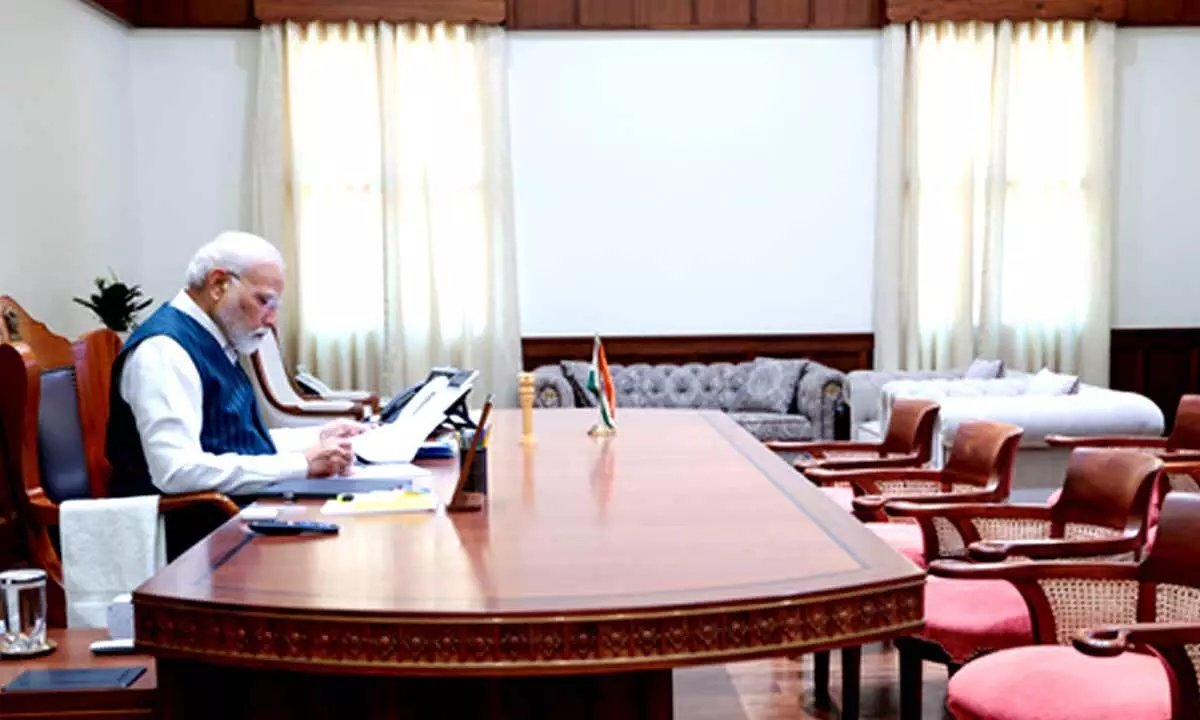Live
- All you need to know about PAN 2.0
- Akasa Air redefines travel experience with industry-first offerings
- MP: Residents stage protests against liquor shop in Indore
- Telugu Actor Shri Tej Booked for Alleged Cheating and False Promise of Marriage in Live-in Relationship
- Toyota Kirloskar Motor Celebrates 1 Lakh Urban Cruiser Hyryder on Indian Road
- MLS: New York City FC part ways with head coach Nick Cushing
- Delhi CM says Centre cutting AAP voters’ names from rolls, BJP hits back
- Hyderabad Metro Rail Phase-II Works to Begin in Old City in January 2025
- Odisha: 668 persons killed in human-elephant conflicts in last three years
- DEFENDER JOURNEYS: TO EMBARK ON ITS THIRD EDITION FROM NOVEMBER 2024
Just In
PM Modi has approval rating of 65% in Sept this year: Ipsos INdiaBus polls

Prime Minister Narendra Modi has achieved an approval rating of 65 per cent among urban Indians, as of September 2023, as per the Ipsos IndiaBus Poll.
New Delhi: Prime Minister Narendra Modi has achieved an approval rating of 65 per cent among urban Indians, as of September 2023, as per the Ipsos IndiaBus Poll.
According to the new wave of the Ipsos IndiaBus Poll, Modi has achieved an Approval Rating (AR) of 65 per cent among urban Indians. While seven per cent were neutral, 18 per cent disapproved and nine per cent were undecided.
The Prime Minister had an approval rating of 60 per cent in December 2022, which grew to 67 per cent in February this year and stood at 65 per cent in September this year.
Highlighting the approval of the Prime Minister zone wise, cities, SECs, age groups, cohorts and how he stacks up, the poll stated that zone wise, the approval rating outcome showed Modi achieving higher rating in western India with 80 per cent, followed by eastern India with 73 per cent approval, northern India with 72 per cent and though in southern India his approval rating was a measly 31 per cent.
It further stated that his approval rating was higher in tier 1 with 76 per cent, tier 2 with 64 per cent and tier 3 with 62 per cent vis-à-vis metros with 58 per cent.
The poll pointed out that interestingly, his AR was almost the same across SECs – SEC A with 69 per cent, SEC B with 64 per cent and SEC C with 63 per cent.
The poll further stated that approval rating across the two genders was almost at par – women (65 per cent) and men (64 per cent).
“Similar trend was noticeable across age groups where his approval rating was steady -- 18-30 year old age group with 66 per cent, between 31-45 years with 64 per cent and for 45+ with 64 per cent.
“Also across the different cohorts, his approval rating was high -- unemployed with 75 per cent, students with 69 per cent, employed with 67 per cent and full time parent or homemaker with 63 per cent, with the exception of the self employed with 47 per cent.
“Notably, those with higher education gave a higher approval rating of 70 per cent to Modi versus those with lower education, who gave an AR of 61 per cent,” the poll said.
Commenting on the pollreport, Parijat Chakraborty, Group Service Line Leader, Public Affairs, Corporate Reputation, ESG and CSR said: “Prime Minister Modi has achieved an approval rating of 65 per cent on how Indians perceive his role as the Prime Minister of the country.”
He said that by and large across demographics Modi has received high approval ratings considering some respondents were undecided or were neutral.
“His disapproval in less than 2 in 10, while his approval is 2 in 3 of those polled. Only the residents of south zone and the self employed seem disgruntled.
“Under his stewardship India has been shining on several fronts, recently he has gathered new feathers in his cap of Chandrayaan 3, Aditya L1 and India successfully hosting the G20 Summit. He also has the gift of the gab and connects with audiences across SECs and age groups,” Chakraborty added.
The survey used a structured questionnaire among over 2,200 respondents from SEC A, B and C households, covering adults of both genders from all four zones in the country.
The survey was conducted in metros, Tier 1, Tier 2 and Tier 3 towns, providing a more robust and representative view of urban Indians. The respondents were polled face-to-face and online.
The data is weighted by demographics and city-class population to arrive at the national average, Ipsos India said.

© 2024 Hyderabad Media House Limited/The Hans India. All rights reserved. Powered by hocalwire.com






